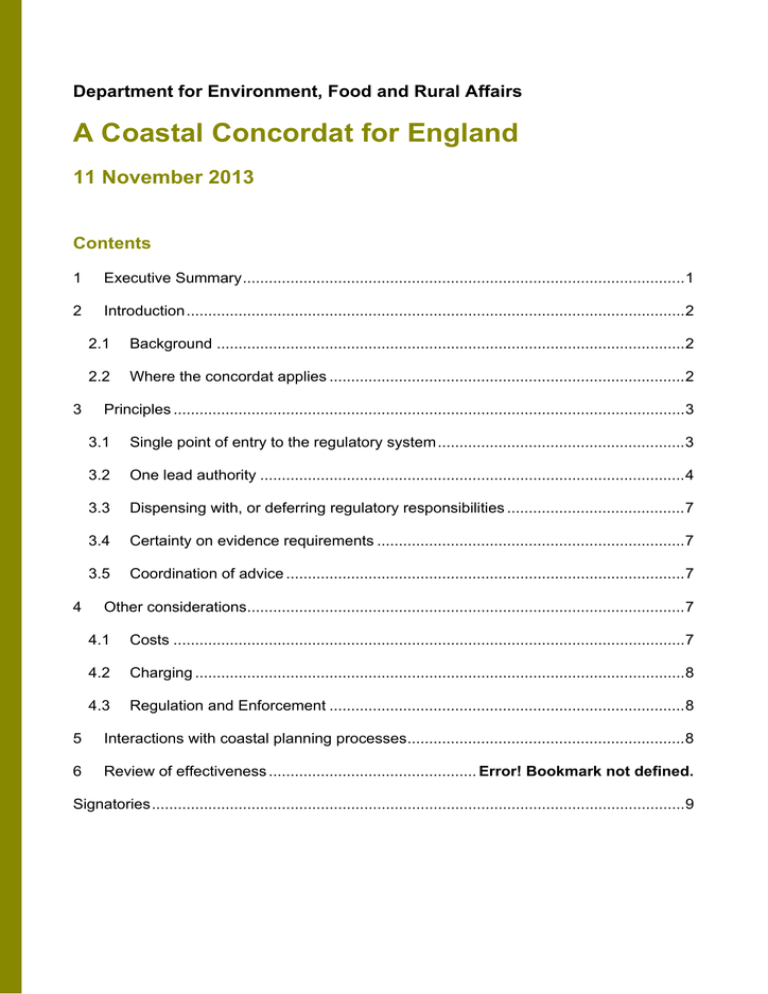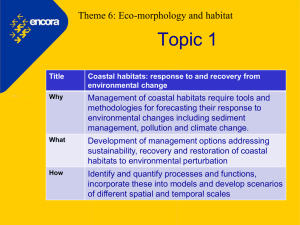A Coastal Concordat for England 11 November 2013 Contents
advertisement

Department for Environment, Food and Rural Affairs A Coastal Concordat for England 11 November 2013 Contents 1 Executive Summary ...................................................................................................... 1 2 Introduction ................................................................................................................... 2 3 4 2.1 Background ............................................................................................................ 2 2.2 Where the concordat applies .................................................................................. 2 Principles ...................................................................................................................... 3 3.1 Single point of entry to the regulatory system ......................................................... 3 3.2 One lead authority .................................................................................................. 4 3.3 Dispensing with, or deferring regulatory responsibilities ......................................... 7 3.4 Certainty on evidence requirements ....................................................................... 7 3.5 Coordination of advice ............................................................................................ 7 Other considerations..................................................................................................... 7 4.1 Costs ...................................................................................................................... 7 4.2 Charging ................................................................................................................. 8 4.3 Regulation and Enforcement .................................................................................. 8 5 Interactions with coastal planning processes................................................................ 8 6 Review of effectiveness ................................................ Error! Bookmark not defined. Signatories ........................................................................................................................... 9 1 Executive Summary This coastal concordat is an agreement between the Department for Environment, Food and Rural Affairs, the Department for Communities and Local Government, the Department for Transport, the Marine Management Organisation, the Environment Agency, Natural England and the Local Government Association’s Coastal Special Interest Group. 1 It sets out the principles according to which the regulatory and advisory bodies propose to work with local planning authorities 2 to enable sustainable growth in the coastal zone. The concordat applies to the consenting 3 of coastal developments in England where several bodies have a regulatory function, and is designed to form the basis of agreements between the main regulatory bodies and coastal local planning authorities. It provides a framework within which the separate processes for the consenting of coastal developments in England can be better coordinated. The concordat is based on five high level principles, as set out below: 1. Applicants seeking regulatory approval should be provided with a single point of entry into the regulatory system for consenting coastal development, guiding them to the organisations responsible for the range of consents, permissions and licences that may be required for their development. 2. Regulators should agree a single lead authority for coordinating the requirements of Environmental Impact Assessment Directive or Habitats Regulations Assessments. 3. Where opportunities for dispensing or deferring regulatory responsibilities are legally possible and appropriate, they should be taken. 4. Where possible, at the pre-application stage, competent authorities and statutory advisors should agree the likely environmental and habitats assessment evidence requirements of all authorities at all stages of the consenting process. 5. Where possible regulators and statutory advisors should each provide coordinated advice to applicants from across their respective organisations. 1 National Parks England is also a signatory to the concordat. local planning authorities include Unitary or District Councils and National Park Authorities 3 Consenting refers to the various consents, permissions and licences needed for a development to become operational. The consenting process has both advisory and decision making roles within it, and the concordat applies across both these roles 2 1 2 Introduction 2.1 Background This concordat is one of a suite of actions the Government and regulatory bodies are taking to achieve more efficient, coordinated regulation. In autumn 2012, the Better Regulation Executive of the Department for Business Innovation and Skills conducted a Focus on Enforcement review of enforcement as it affects coastal projects and investments 4 . One of the main conclusions of this review was that businesses found it difficult to understand and deal with overlaps between regulators. In consultation with the Marine Management Organisation and other relevant regulators, the Department for Environment, Food and Rural Affairs (Defra) published an action plan 5 responding to the review’s findings. The action plan included a commitment by Defra to lead on rapid agreement and conclusion of a marine/coastal development concordat. The concordat has been drafted by a working party led by Defra in collaboration with Department for Communities and Local Government, the Department for Transport, the Marine Management Organisation, the Environment Agency, Natural England and the Local Government Association’s Coastal Special Interest Group representing coastal authorities. The concordat should, among other things, aim to provide applicants with a single point of entry spanning all of the regulatory systems. The concordat will be implemented by the main regulatory and advisory bodies (the Marine Management Organisation, the Environment Agency, Natural England) in collaboration with coastal local planning authorities. The Local Government Association Coastal Special Interests Group endorses the concordat and will recommend the principles to local authorities, while recognising that this is not a mandatory requirement. The Government Departments which are signatories to this concordat will support and promote its principles. The concordat provides a framework within which the separate processes for the consenting of coastal developments in England can be better coordinated. It offers benefits to applicants, regulators and advisors alike by reducing unnecessary regulatory duplication, providing better sign-posting, streamlining assessments and increasing transparency and consistency of advice. 2.2 Where the concordat applies This concordat sets out principles for coordinating the consenting process for coastal development in England and provides a framework within which public bodies relevant to this process can deliver a more effective and efficient service. 4 https://www.gov.uk/government/uploads/system/uploads/attachment_data/file/88425/bis-13-616-review-ofcoastal-projects-and-investments-focus-on-enforcement.pdf 5 http://discuss.bis.gov.uk/focusonenforcement/files/2013/02/Defra-Response-to-Coastal-Projects-Review.pdf 2 The concordat applies to all applications for all coastal development, except those where coordination mechanisms are already in place, for example under the Planning Act 2008, the Transport and Works Act 1992 or Hybrid Bills. In this context, coastal development means individual projects which span the intertidal area in estuaries and on the coast and require multiple consents including both a marine licence and a planning permission from the local planning authority. It will not apply to projects that are solely terrestrial. The concordat is a standalone agreement about the consenting phase of development, but complements other Government-agency led initiatives to promote sustainable growth. 3 Principles The concordat is based on five high level principles that the signatories will promote, as set out below: 1. Applicants seeking regulatory approval should be provided with a single point of entry into the regulatory system, guiding them to the organisations responsible for the range of consents, permissions and licences may be required for their development. 2. Regulators should agree a single lead authority for coordinating the requirements of the Environmental Impact Assessment (EIA) Directive or Habitats Regulations Assessments (HRA). 3. Where opportunities for dispensing or deferring regulatory responsibilities are legally possible and appropriate, they should be taken. 4. Where possible, at the pre-application stage, competent authorities and statutory advisors should agree the likely environmental assessment evidence requirements of all authorities at all stages of the consenting process. 5. Where possible regulators and statutory advisors should each provide coordinated advice to applicants from across their respective organisations. 3.1 Single point of entry to the regulatory system The regulatory landscape at the coastal zone is a complex one. There are at least three main regulators (the local planning authority, the Marine Management Organisation and the Environment Agency) with many other public bodies having regulatory powers in specific locations or circumstances (e.g. Department for Energy and Climate Change, Coast Protection Authorities, Natural England, harbour authorities, Maritime and Coastguard Agency, Trinity House, Inshore Fisheries and Conservation Authorities). The principle of having a single point of entry means that an applicant should only need to contact one of the regulatory or advisory bodies who are signatories to this agreement who would then signpost the applicant to other relevant signatories, and where appropriate, would themselves make contact with relevant consenting bodies. The concept of a single point of entry is not intended to place additional demands on any party, rather it is a means of providing a more efficient and effective way of working for all. The single point of entry can be further detailed as: 3 • • • • • • When someone applies for a consent, licence or permission from the local planning authority, the Marine Management Organisation, the Environment Agency or Natural England, or requests information regarding a consent, licence or permission from any of these bodies, the single point of entry to the regulatory system should be whichever one of these bodies the person first approaches. The body acting as the single point of entry does not necessarily have to take the role of the lead authority for the Environmental Impact Assessments or Habitats Regulation Assessments. (see 3.2 below). Upon entry to the regulatory system, based on the information submitted by the applicant at that time, the body acting as the single point of entry should inform the applicant they are likely to need further consents, licences or permissions from other bodies as relevant. However, it remains the ultimate responsibility of the applicant to obtain all necessary consents. Where appropriate, the body acting as the single point of entry should inform all other concordat signatories, and where they can be identified, other consenting bodies that an application or an advice request has been received. In order to deliver effectively upon this principle, all concordat signatories will need to be aware of each other’s regulatory responsibilities and have established processes, which will ensure that the principle is implemented effectively. Where relevant, the body acting as the single point of entry should inform the applicant of the concordat. 3.2 One lead authority The aim of this principle is to reduce the duplication of evidence requirements and to streamline the regulatory process, in particular production of Environmental Statements under the Environmental Impact Assessment Regulations or Habitats Regulations Assessment under the Habitats Regulations for the same project by different regulators. This principle does not remove any of the statutory responsibilities or duties of any regulatory authority, but it does set out a mechanism by which the production of evidence supporting decision-making can be streamlined. In summary, upon identifying that applications for more than one consent, licence or permission require an Environmental Impact Assessment or Habitats Regulations Assessment a lead authority for coordinating relevant assessment processes should be identified and, where appropriate, parallel tracking 6 of assessments should be recommended. 3.2.1 Environmental Impact Assessment This principle can be further detailed as: 6 This is in line with the principles set out in the Environment Agency’s “Guidance for developments requiring planning permission and environmental permits” http://www.environmentagency.gov.uk/business/regulation/139378.aspx 4 • The signatories who are relevant competent authorities with respect to a particular proposal should reach agreement on who is the most appropriate lead authority for coordinating a shared Environmental Statement. • The following guidance, which is based upon Defra guidance on determining a lead competent authority under the Habitats Regulations 7 , should be applied when determining a lead authority to coordinate an Environmental Impact Assessment: o Where a single technical issue is more important than any other in assessing the impacts of a plan or project, the competent authority with the required technical expertise could lead; o Where there are a large number of complex cross-cutting issues, the competent authority with greatest capacity to undertake the work could lead; o Where a plan or project cuts across administrative boundaries (e.g. between planning authorities), the competent authority with the principal interest could lead. • The lead competent authority will then coordinate a decision on whether a shared Environmental Statement can be produced, what the respective roles and responsibilities are, a timetable for work, and how work will be resourced. Each competent authority will need to be satisfied that the Environmental Statement contains the information that it requires. • To reduce duplication of effort for all parties during the Environmental Impact Assessment process, where there is no legal mechanism to defer decision making formally from one competent authority to another (such as under the Town and Country Planning (Environmental Impact Assessment) Regulations 2011), one competent authority should be appointed as the administrative lead. This means that consultation and assessment at the screening and scoping stages of the process is only carried out once and one Environmental Statement covers all relevant Environmental Impact Assessment requirements. Each competent authority will need to be satisfied that the Environmental Statement contains the information that it requires. In practice, for a project that is mainly terrestrially based, the local planning authority may be the overall decision maker with regards to an Environmental Impact Assessment, notwithstanding the fact that the Marine Management Organisation may need to issue separate consents based upon that Environmental Impact Assessment process. Similarly for a project that is mainly marine-based the Marine Management Organisation may be the overall decision maker with regards to an Environmental Impact Assessment, albeit in an administrative rather than a formal manner. During the Environmental Impact Assessment process, the local planning authority would rely on the Marine Management Organisation to provide advice on marine aspects, the Environment Agency to provide advice on its regulatory responsibilities (including flood 7 https://www.gov.uk/government/uploads/system/uploads/attachment_data/file/69580/pb13809-habitatsguidance.pdf 5 and coastal erosion risk management, pollution control and fisheries) and environmental duties such as for the Water Framework Directive, and Natural England to provide advice on its own regulatory responsibilities (e.g. terrestrial wildlife licensing) and terrestrial and marine conservation matters in a coordinated manner. Similarly if the Marine Management Organisation was the administrative lead on the Environmental Impact Assessment process they would rely on the local planning authority for advice on terrestrial aspects. This should result in an Environmental Statement that is robust enough that the Marine Management Organisation could defer their responsibilities under the Marine Works (Environmental Impact Assessment) Regulations and use the Environmental Impact Assessment consent decision of the local planning authority to inform their decision on any related marine licence. This procedure should apply regardless of which is the lead authority or under what regulations the Environmental Impact Assessment decision is being made. Similarly, if the Marine Management Organisation were the administrative lead, an Environmental Statement would be produced that would enable the local planning authority to make their decision under their Environmental Impact Assessment Regulations. 3.2.2 Habitats Regulations Assessment This principle can be further detailed as: • The relevant competent authorities should reach agreement on who is the most appropriate lead authority for coordinating an Habitats Regulations Assessment. • In line with Defra guidance on determining a lead competent authority under the Habitats Regulations 8 , the following guidance should be applied to determination of a lead authority to coordinate an Habitats Regulation Assessment: o Where a single technical issue is more important than any other in assessing the impacts of a plan or project, the competent authority with the required technical expertise could lead; o Where there are a large number of complex cross-cutting issues, the competent authority with greatest capacity to undertake the work could lead; o Where a plan or project cuts across administrative boundaries (e.g. between planning authorities), the competent authority with the principal interest could lead. • The lead competent authority will then coordinate a decision on whether a shared Habitats Regulation Assessment can be produced, what the respective roles and responsibilities are, a timetable for work, and how work will be resourced. Each competent authority will need to be satisfied that the Habitats Regulation Assessment contains all the information that it required. 8 https://www.gov.uk/government/uploads/system/uploads/attachment_data/file/69580/pb13809-habitatsguidance.pdf 6 • The lead competent authority for Habitats Regulation Assessment does not necessarily need to be the same lead competent authority for an Environmental Impact Assessment. For example, there may be a mainly terrestrial project where the only effects that need assessing under the Habitats Regulations are on a European Marine Site. In this instance the technical expertise needed to lead an Environmental Impact Assessment and Habitats Regulation Assessment will be different, and this should be reflected in the lead competent authorities for different regimes. 3.3 Dispensing with, or deferring regulatory responsibilities The signatories should ensure that they explore the legal options available for streamlining within the regulatory process. Where opportunities for dispensing or deferring regulatory responsibilities are legally possible and appropriate, they should be taken (e.g. dispensing with flood defence consents where the terms and conditions of a marine licence mean that the requirement of such a consent can be dispensed with). 3.4 Certainty on evidence requirements Applicants should be encouraged to undertake early engagement to identify common evidence needs across different consenting regimes and enable the parallel tracking of any work required to satisfy evidence requirements where appropriate. Wherever possible, the information contained within any regulatory assessment should be sufficient for both the marine licence and the planning application approvals and may inform other relevant consents, licences and permissions. 3.5 Co-ordination of advice Where either the local planning authorities, the Marine Management Organisation, the Environment Agency or Natural England are acting in a regulatory or advisory capacity for a coastal development project, each body should ensure that it is providing coordinated advice across its organisation within agreed timescales. 4 Other considerations 4.1 Costs Implementation of the concordat should generate long term efficiency savings for regulators, advisors and applicants. In order to realise these savings local planning authorities, the Marine Management Organisation, Natural England and the Environment Agency may need to invest in training and raising awareness, for example in order to be able to provide the single point of entry. But overall they will benefit from making the 7 regulatory process more coordinated and efficient for all parties within their current processes. The costs to the applicant are expected to decrease through better working; there should be less time needed for individual discussions with all the bodies concerned. Where an applicant parallel tracks applications, evidence may only need to be produced once, rather than many times. 4.2 Charging The concordat will not have any implications for the charging regimes of any of the signatories, who will each charge for any services within their own legal remits. 4.3 Regulation and Enforcement This concordat does not amend or remove the regulatory or enforcement responsibilities of any signatory party. 5 Interactions with coastal planning processes Coastal development consenting needs to be undertaken with due regard to the relevant policies, plans and programmes that apply in the coastal area. These may include the National Planning Policy Framework, the Marine Policy Statement and other national policy statements, marine plans, local and neighbourhood plans, shoreline management plans, river basin management plans and coastal change management areas. 6 Review of effectiveness The effectiveness of the concordat will be reviewed 12 months after formal signing. 8 Signatories George Eustice MP, Parliamentary Under-Secretary (Department for Environment, Food and Rural Affairs) Stephen Hammond MP, Parliamentary Under-Secretary (Department for Transport) (Roads and Motoring) Nick Boles MP, Parliamentary Under-Secretary (Department for Communities and Local Government) (Planning) James Cross, Chief Executive, Marine Management Organisation Dave Webster, Chief Executive, Natural England Dr Paul Leinster MBE, Chief Executive, Environment Agency Cllr Andy Smith, Chairman, LGA (Coastal Special Interests Group) Jim Bailey, Chair, National Parks England 9 © Crown copyright 2013 You may re-use this information (not including logos) free of charge in any format or medium, under the terms of the Open Government Licence. To view this licence, visit www.nationalarchives.gov.uk/doc/open-government-licence/ or write to the Information Policy Team, The National Archives, Kew, London TW9 4DU, or e-mail: psi@nationalarchives.gsi.gov.uk This document/publication is also available on our website at: https://www.gov.uk/government/publications Any enquiries regarding this document/publication should be sent to us at: amanda.furlonger@defra.gsi.gov.uk Marine Programme Support Office, Marine Programme, Defra, 8A/B Millbank, c/o Nobel House, Smith Square, SW1P 3JR. Tel: 020 7238 6830 PB 14060 10







